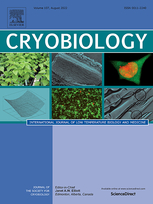
Trehalose-mediated protection of the plasma membrane H+-ATPase from Kluyveromyces lactis during freeze-drying and rehydration.
Author(s) : SAMPEDRO J. G., GUERRA G., PARDO J. P., URIBE S.
Type of article: Article
Summary
The protective efficiency of carbohydrates was as follows: trehalose higher than maltose higher than sucrose higher than glucose higher than galactose. Each carbohydrate exhibited the maximal protection at a concentration of 20 milligrams carbohydrate per milligram of protein or above. Trehalose, at 20 milligrams/milligram protein, protected the enzyme activity completely during freeze-drying and rehydration. Rehydration temperature was critical; at 20 deg C or below, activity was fully retained, while at 30, 40, or 50 deg C activity decreased in proportion with temperature. Storage at 4 deg C resulted in retention of most of the enzymatic activity for 60 days. The protection of the H+-ATPase by trehalose suggests that this carbohydrate might protect other membrane enzymes from inactivation during handling.
Details
- Original title: Trehalose-mediated protection of the plasma membrane H+-ATPase from Kluyveromyces lactis during freeze-drying and rehydration.
- Record ID : 1999-2577
- Languages: English
- Source: Cryobiology - vol. 37 - n. 2
- Publication date: 1998/09
Links
See other articles in this issue (3)
See the source
Indexing
- Themes: Freeze-drying in biology and medicine
- Keywords: Freeze-drying; Cryoprotectant; Cryobiology; Microorganism
-
VIABILITY OF LYOPHILIZED ANAEROBES IN TWO MEDIA.
- Author(s) : STAAB J. A., ELY J. K.
- Date : 1987
- Languages : English
- Source: Cryobiology - vol. 24 - n. 2
View record
-
Freeze-drying of Bacillus subtilis, Aureobasidi...
- Author(s) : POPESCU C., IONESCU C., DAVID C.
- Date : 1995/07
- Languages : English
- Source: Cryo-Letters - vol. 16 - n. 4
View record
-
Small, acid-soluble proteins bound to DNA prote...
- Author(s) : FAIRHEAD H., SETLOW B., WAITES W. M., SETLOW P.
- Date : 1994/07
- Languages : English
- Source: Appl. environ. Microbiol. - vol. 60 - n. 7
View record
-
THE UTILITY OF ACCELERATED THERMAL DEGRADATION ...
- Author(s) : BOLTASU G.
- Date : 1979/01
- Languages : English
- Source: Arch. roum. Pathol. exp. Microbiol. - vol. 38 - n. 1
View record
-
FREEZE-DRYING OF MICROBIAL PLATES.
- Author(s) : KADETOV V. V., NATALIC L. A., TERENT'EV A. N.
- Date : 1987
- Languages : Russian
- Source: Kriobiologija - n. 4
View record
